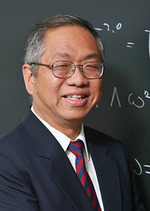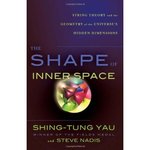Geometry: From Riemann to Einstein and On to String Theory
Shing–Tung Yau
Monday, 12 Nov 2012 at 7:00 pm – Sun Room, Memorial Union
String theory says we live in a ten-dimensional universe, but that only four dimensions are accessible to our everyday senses. According to theorists, the missing six are curled up in bizarre structures known as Calabi-Yau manifolds. Shing-Tung Yau is the man who mathematically proved that these manifolds exist. He is the Graustein Professor of Mathematics at Harvard University. He has won many awards, including the Fields Medal, the National Medal of Science, a MacArthur Fellowship, the Crafoord Prize, Wolf Prize and the Veblen Prize. In 1993 he was elected to the National Academy of Sciences. His list of publications includes twenty books, including The Shape of Inner Space, in which he argues that geometry is fundamental not only to string theory but also to the very nature of our universe.More on The Shape of Inner Space:
Time and again, where Yau has gone, physics has followed. Now, for the first time, readers get to follow Yau’s penetrating thinking on where we’ve been, and where mathematics will take us next. A fascinating exploration of a world we are only just beginning to grasp, The Shape of Inner Space will change the way we consider the universe on both its grandest and smallest scales.
From a Harvard Gazette article:
Shing-Tung Yau sees a beautiful universe around him, crafted by nature into the shapes and forms we see every day. Mathematics describes those shapes and forms, the discipline of geometry in particular. So, to Yau, it shares nature’s beauty.
Yau is trying to bring math out of the closet. Its practitioners, he said, are not strange or reclusive, as the public sometimes perceives them, but rather scientists trying to understand the orderly principles that describe the world around us.
Isaac Newton, for example, made major contributions to calculus in order to describe the motions of the planets. Mathematicians draw insights from their work with numbers, shapes, and forms that can help other scientists, especially physicists, in their work.
“I think people don’t understand that we are scientists and make fundamental contributions,” Yau said. “We can help physicists; we can help engineers.”
Cosponsored By:
- College of Engineering
- College of Liberal Arts & Sciences
- Committee on Lectures (funded by Student Government)
Stay for the entire event, including the brief question-and-answer session that follows the formal presentation. Most events run 75 minutes.
Sign-ins are after the event concludes. For lectures in the Memorial Union, go to the information desk in the Main Lounge. In other academic buildings, look for signage outside the auditorium.
Lecture Etiquette
- Stay for the entire lecture and the brief audience Q&A. If a student needs to leave early, he or she should sit near the back and exit discreetly.
- Do not bring food or uncovered drinks into the lecture.
- Check with Lectures staff before taking photographs or recording any portion of the event. There are often restrictions. Cell phones, tablets and laptops may be used to take notes or for class assignments.
- Keep questions or comments brief and concise to allow as many as possible.





